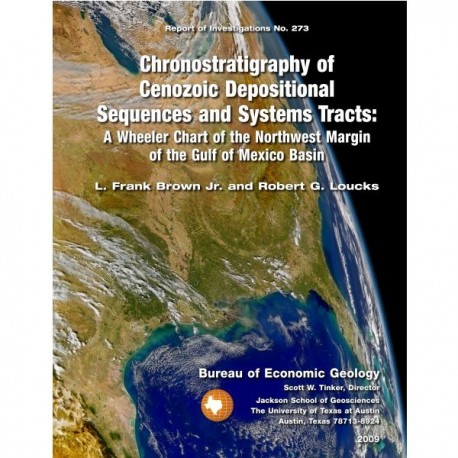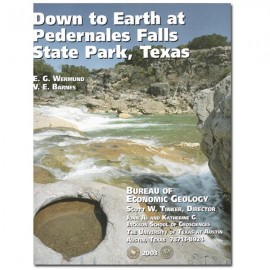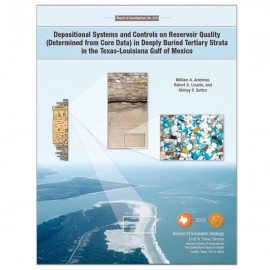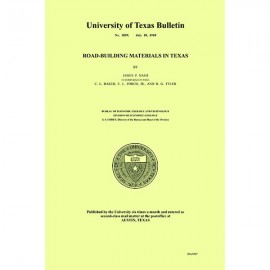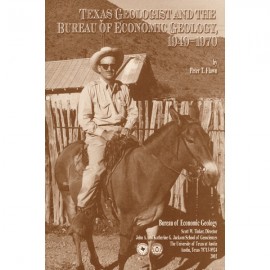Reports of Investigations
-
Books & Reports
- Reports of Investigations
- Guidebooks
- Udden Series
- Geological Circulars
- Down To Earth
- Atlases of Major Oil and Gas Reservoirs
- Texas Memorial Museum Publications
- Environmental Geologic Atlas of the Texas Coastal Zone
- Mineral Resource Circulars
- Other Reports
- Seminars and Workshops
- Handbooks
- Submerged Lands of Texas
- Symposia
- Annual Reports
- Open File Reports
-
Maps & Cross Sections
- Thematic Maps
- Miscellaneous Maps, Charts & Sections
- Geologic Atlas of Texas
- STATEMAP Project Maps
- Geologic Quadrangle Maps
- Cross Sections
- Highway Geology Map
- Energy and Mineral Resource Maps
- Shoreline Change and Other Posters
- Wilcox Group, East Texas, Geological / Hydrological Folios
- Bouguer Gravity Atlas of Texas
- River Basin Regional Studies
- Featured Maps
- Posters
- Teachers & the Public
-
Geological Society Publications
- Gulf Coast Association of Geological Societies
- Alabama Geological Society
- Austin Geological Society
- Corpus Christi Geological Society
- Houston Geological Society
- Lafayette Geological Society
- Mississippi Geological Society
- New Orleans Geological Society
- South Texas Geological Society
- GCS SEPM Publications
- Historic BEG & UT Series
Chronostratigraphy of Cenozoic Depositional Sequences and Systems Tracts: A Wheeler Chart
RI0273
For a downloadable, digital version: RI0273D.
RI0273. Chronostratigraphy of Cenozoic Depositional Sequences and Systems Tracts: A Wheeler Chart of the Northwest Margin of the Gulf of Mexico Basin, by L. F. Brown Jr. and R. G. Loucks. 28-p. text, 1 oversized color chart, 2009. Print.
To purchase this publication as a downloadable PDF, please order RI0273D.
ABSTRACT
A chronostratigraphic chart (Wheeler chart) was constructed of the Cenozoic strata of the northwest margin of the Gulf of Mexico basin (Texas coastal area). This sequence stratigraphic framework divides outcrop and subsurface lithostratigraphic units (members, formations, and groups) into 50 chronostratigraphic (sequence) and lithogenetic (depositional systems) packages. The framework links the outcrop with the more extensive subsurface stratigraphy. The diagrammatic paleoslope systems-tract profiles provide the subsurface geologist with an inferred but integrated view of the depositional elements that define each principal siliciclastic impulse of sediment delivered into the basin. Although absolute ages on the chronostratigraphic chart are equivocal, they do place the sedimentary record into a logical outcrop-to-deep-basin relative perspective.
The chronostratigraphic chart was constructed for the benefit of not only subsurface petroleum geoscientists, but also academic and other researchers working on outcrop stratigraphy, sedimentology, paleontology, and petrography. This nonproprietary chronographic chart ought to encourage Gulf Coast geoscientists either to modify the chart with their own proprietary data or release their own proprietary chronostratigraphic documents. Through further enhancement of the Wheeler chart, a deeper understanding of the architecture and depositional history of the Gulf of Mexico can be achieved, thus leading to a more complete understanding of the petroleum systems of the Gulf of Mexico.
Keywords: Cenozoic, chronostratigraphy, depositional sequences, Gulf of Mexico basin, sequence stratigraphy, system tracts, Tertiary, Wheeler chart
CONTENTS
Abstract
Introduction
Concept of a Cenozoic Sequence Stratigraphic Chart
Geochronology vs. Chronostratigraphy vs. Lithostratigraphy
Wheeler Diagrams
Sources of Data Used to Prepare Wheeler Chart
Lithostratigraphy, Nomenclature, and Literature Sources
Subsurface Geology
Micropaleontology
Ages (Ma) of Sequence Stratigraphic Surfaces
Methodology
Key Aspects of Graphic Presentation of Sequence Stratigraphy Displayed on Chronostratigraphic Chart
Legend
Characterization of Stratal Units (Parasequence Sets
Frequencies of Sequences and Systems Tracts
Coastal and Slope (Marine) Onlap
Sequences and Sequence Boundaries: Key Sequence Surfaces
Type-1 Unconformity = Type-1 Sequence Boundary
Type-2 Unconformity = Type-2 Sequence Boundary
Incised-Valley Erosion (iv) Surface
Transgressive (Ravinement Erosion) Surface (TS)
Marine Condensed Sections (mcs = mfs)
Sequence Stratigraphic Systems Tract Components
Depositional Systems
Lowstand Depositional Systems Tracts (LST’s)
Incised-Valley-Fill (ivf) Systems
Basin-Floor Fans and Channel-Fill (bff) Systems
Slope-Fan Systems (sf’s)
Prograding Deltaic Wedge (pw) or Prograding Complex Systems
On-Shelf Type-1 Lowstand (Shelf/Ramp) Systems Tracts
Transgressive Systems Tracts (TST’s)
Highstand Systems Tracts (HST’s)
Relationship of Hydrocarbon Systems and Sequence Stratigraphy
Sequences and Systems Tracts of the Texas Gulf of Mexico Basin Margin
Tertiary Paleocene Series—Midway Group
Sequence 1 (66.5–64.05 Ma): Kincaid Formation
Sequence 2 and Lower Part of Sequence 3 (64.05–59.2 Ma): Wills Formation
Tertiary Paleocene-Eocene Series—Wilcox Group
Upper Part of Sequence 3 (60.9–59.2 Ma): Hooper Member of the Seguin Formation
Sequence 4 (58.5–54.9 Ma): Solomon Creek, Caldwell Knob, Butler, and Simsboro Members of the Seguin Formation and Lower Part of the Rockdale Formation
Sequence 5 (54.9–49.5 Ma): Calvert Bluff Member, Sabinetown Formation, and Lower Part of Carrizo Formation
Tertiary Eocene Series—Claiborne Group
Sequence 6 (49.5–48.5 Ma): Carrizo Lowstand, Unnamed TST and HST
Sequence 7 (48.5–46.5 Ma): Reklaw and Queen City Formations
Sequence 8 (46.5–43.6 Ma): Weches and Sparta Formations
Sequence 9 (43.6–40.0 Ma): Cook Mountain and Yegua Formations
Tertiary Eocene Series—Jackson Group
Sequence 10 (40.0–36.6 Ma) Moodys Branch TST and Lower Jackson Group HST
Lower Part of Sequence 11 (36.6–33.47 Ma) Upper Jackson (TST)
Tertiary Oligocene Series—Vicksburg Group
Upper Part of Sequence 11 (33.47–32.5 Ma): Vicksburg HST
Tertiary Oligocene Series—Catahoula Group
Sequence 12 (32.5–30.7 Ma): Unnamed TST, Catahoula, and Basal Frio Cycle 1
Sequences 13–18 (30.7–24.1 Ma): Frio Cycle 2– Cycle 6 and Anahuac Shale Mbr
Tertiary Miocene Series—Fleming Group
Sequences 19–Lower Part of 23 (24.1–16.3 Ma): Oakville Formation
Sequences 23 (Upper Part) through 31 (16.3–5.65 Ma): Lagarto Formation
Tertiary Pliocene Series—Citronelle Group
Sequences 32–38 (5.65–3.04 Ma): Goliad Formation
Sequences 39–42 (3.04–1.72 Ma): Willis Formation
Quaternary System—Pleistocene-Holocene Series—Houston Group
Sequences 43–49 (1.7–0.001 Ma): Lissie, Montgomery, Beaumont Formations
Sequence 50 (1.01–0.0 Ma): Holocene (TST)
Conclusions
Acknowledgments
References
Appendix A: Glossary of Sequence and Depositional Systems Terms
Appendix B: Representation of Various Geochronologic Units or Divisions and Their Contained Rock Successions
Citation
Brown, L. F., Jr., and Loucks, R. G., 2009, Chronostratigraphy of Cenozoic Depositional Sequences and Systems Tracts: A Wheeler Chart of the Northwest Margin of the Gulf of Mexico Basin: The University of Texas at Austin, Bureau of Economic Geology, Report of Investigations No. 273, 28 p., 1 chart.
